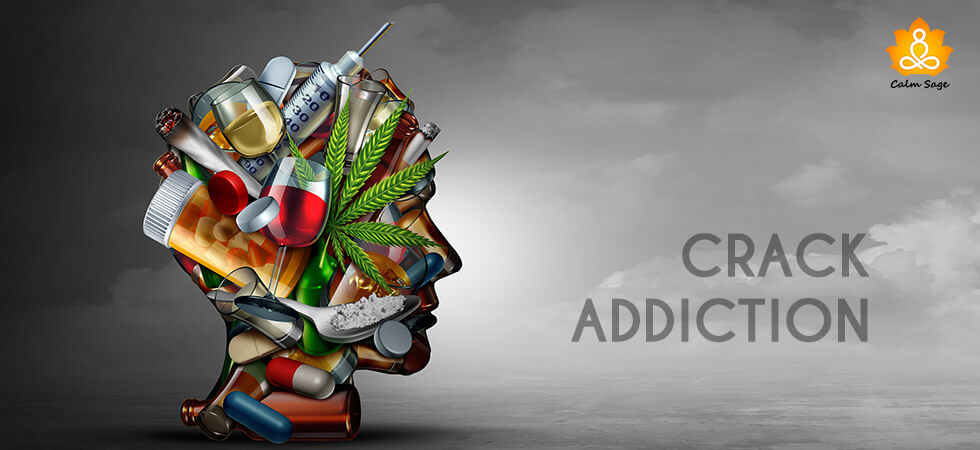What Is Crack Addiction?

Excessive usage of crack cocaine can cause an overdose or other serious or life-threatening side effects. If you or a loved one are struggling with substance use or addiction, contact the Substance Abuse and Mental Health Services Administration (SAMHSA) National Helpline at 1-800-662-4357
Crack addiction is a type of substance use disorder that can be characterized by physiological dependence on the substance. For example, an individual struggling with crack addiction might lose control whenever they discontinue use of the substance. Despite knowing the consequences, people still continue to use the substance.
Scientifically, substance use is categorized under brain disorder. People who are struggling with cocaine addiction tend to have a chronic medical condition that requires proper diagnosis and treatment.
In this blog, we will be taking a deep look at what is crack addiction, its symptoms, causes, diagnosis, treatment, and more. So, let’s get started!
What is Crack Addiction?
Crack addiction is a type of substance use disorder that is usually caused by a substance called cocaine. In order to understand the cycle of addiction, let’s just take a brief look at what crack cocaine is.
Cocaine is a stimulant drug that is mined from the coca plant. It looks like a white-fine crystal powder that used to be consumed for medicinal purposes. This stimulant drug is categorized under Schedule II drugs. It is generally used for medicinal purposes such as local anesthesia for eye, ear, or throat surgeries.
However, some people use it as a drug, abusers rub the powder around the gums, snort it, or inject it. Crack is a type of cocaine that is abused through smoking. It is generally processed with water or ammonia wherein it takes the form of rock crystals. Cracks can also be added to marijuana joints or cigarettes.
Crack addiction involves the excessive usage of crack cocaine which is generally identified by the cycle of withdrawal and craving followed by other mental and physical health symptoms. Do you know that around 1.3 million people in the USA struggle with cocaine use disorder?
Crack cocaine addiction can have serious impacts on overall wellbeing which is why proper diagnosis and treatment are required.
Signs and Symptoms of Crack Addiction
Below listed are some of the common signs and symptoms of crack addiction:
- Intense or uncontrollable craving towards the substance
- Required to abuse the drug to feel “normal”
- Increasing drug consumption has the same effect
- Continued usage of the drug despite knowing the consequences
- Losing control over someone else’s drug consumption
- Willing to do anything to receive drugs regularly
- Struggles with withdrawal symptoms such as depression, insomnia, fatigue, or irritability
Below listed are some of the other common symptoms that an individual with crack addiction might face:
- Insomnia
- Lack of attention
- Lack of control over life
- Lack of interest
- Lack of personal hygiene
- Negative consequences associated with family, friends, or workplace
- Severe depression
- Weight loss
Causes of Crack Addiction
Below listed are some of the common causes behind the development of crack addiction:
Genetics: Research shows that genetics plays an important role in the development of crack addiction. I could find a study that stated that people with heredity or genetics related to cocaine use disorder are at risk (approximately 70-75%).
Environmental Factors: Research shows that exposure to environmental factors such as living in a surrounding of alcoholics or substance abusers increases the risk of developing crack addiction or any other type of substance use disorder.
Effects & Risk Factors Associated with Crack Addiction
Mental Health Effects of Crack Addiction
- Developed sensitivity towards senses like touch, light, or sound
- Excessive dopamine rush leads to extreme happiness
- Irritability
- Mental alertness
- Paranoia
- Upsurge in energy levels
- Violent, strange, or unpredictable behavior
Physiological Effects of Crack Addiction
- Dilated pupils
- Increased blood pressure
- Increased body temperature
- Irregular or rapid heartbeat
- Muscle tremors
- Nausea
- Restlessness
Risk Factors Associated with Crack Addiction
- Anxiety or panic attacks
- Brain seizures
- Coma
- Depression
- Heart attack
- Impaired judgment
- Increased blood pressure
- Psychosis
- Respiratory conditions such as bronchitis, pneumonia, cough, and asthma
- Sexual dysfunction
- Stoke
- Sudden cardiac death
Withdrawal Symptoms of Crack Addiction
- Agitation
- Changes in sleep patterns
- Depression
- Exhaustion
- Hallucinations or paranoia
- Lack of focus
- Muscle or body aches
- Nightmares
- Strong or intense cravings
Diagnosis and Treatment of Crack Addiction
Crack addiction is usually diagnosed by clinicians or physical health examiners. The diagnostic process for crack addiction might include a physical examination, screening questions, or a detailed medical history. Additionally, the clinician also evaluates the addiction with the help of the Diagnostic and Statistical Manual of Mental Health Disorders 5th Edition (DSM-5).
Below listed are some of the effective treatment options for crack addiction:
1. Detoxification
Detoxification involves a detox process wherein the client is not allowed to consume substances and might undergo severe withdrawal symptoms. This process involves working through the emotional and physical challenges.
2. Medications
There is no specific medication for treating crack addiction, however, a clinician might prescribe some medications to treat specific symptoms such as nausea, rapid breathing, and others.
3. Therapy
Therapy is one of the most effective treatment options for treating crack addiction as it helps in replacing negative thoughts, works through emotional challenges, and replaces unhealthy behaviors. Generally, cognitive behavioral therapy (CBT) is practiced to replace negative thoughts or behaviors with positive ones.
Other Options
- Motivational Interviewing (MI): MI is a form of psychotherapy wherein the therapist works through self-doubts and improves decision-making abilities. It also helps in increasing hopefulness and self-confidence.
- Contingency Management (CM): CM is a form of behavioral therapy wherein desirable and positive behaviors are promoted. It is an evidence-based technique that promotes recovery and sobriety.
- Community Reinforcement Approach (CRA): CRA is a type of behavioral therapy that works in positive reinforcements, develops skills, improves relationships, supports sobriety, and strengthens resilience.
I hope this blog helps you understand what is crack addiction and how to treat it. Comment down and share your queries related to crack or cocaine addiction or you can also write us at Calm Sage.
For more such content, connect with us through all social media platforms.
Thanks for reading!




















